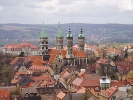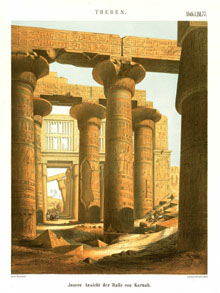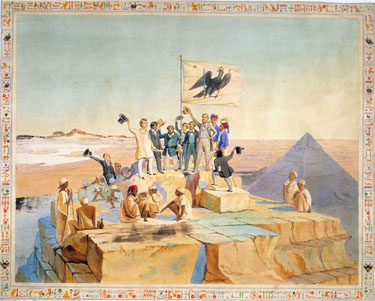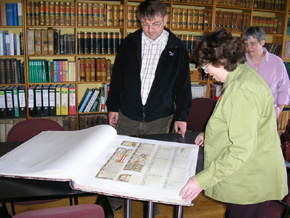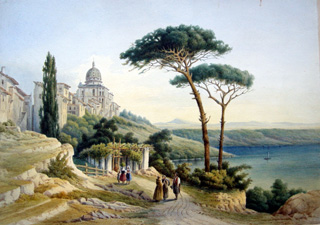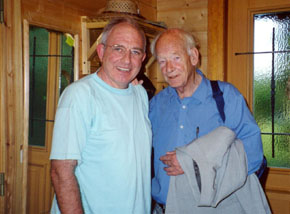Theodor Ernst (Ernst) and Maximilian Ferdinand (Max) were both artists. They accompanied the famous Egyptologist, Lepsius, to Egypt and the Sudan in 1842-1845 and are still renowned for their numerous drawings and paintings which provide a precise record of the hieroglyphs and monuments observed by Lepsius.
Ernst, the third son, was born in Naumburg an der Saale on the 4th of December 1818. He received his first drawing training from his father in Naumburg. In 1837, When he was 18 years old, he moved to Merseburg then on to Dresden where he studied at the Dresden Art Academy. In 1840 Ernst arrived in Berlin to be practise, under Lepsius's guidance, the specialist drawing skills required for the Royal Prussian expedition to Egypt. Lepsius had applied directly to the King for support for Ernst, convincing the king of Ernst's capability by showing the king a painting by Ernst of the Naumburg cathedral.
Max, the fifth son, was born in Naumburg an der Saale on the 6th March, 1823. He received his first drawing training from his father in Naumburg. In 1839, when he was 16 years old, he travelled to Berlin to be trained in hieroglyphics and Egyptology by the Egyptologist, Richard Lepsius, who also came from Naumburg. His first achievement was the 79 lithographs published in 1842, which show the 17.3 m long Turiner "Book of the Dead". For this work Max Weidenbach used “contact prints” of the original, which had been made by Lepsius in 1836.
Please click on an image below to enlarge it.
Temple of Karnak, Thebes
"Denkmäler aus Ägypten und Äthiopien", lepsius 1859
This is one of many architectural and topographical drawings made by the extremely talented artist, Ernst Weidenbach. All details had to be shown with scientific precision.
MEMBERS OF LEPSIUS' 1842 EXPEDITION
CELEBRATING THE KAISER'S BIRTHDAY
ON TOP OF THE CHEOPS PYRAMID
http://aaew.bbaw.de/wbhome/LepsiusArchiv/index.html
The enlargement is the original drawing by J.J.Frey, 1842. It shows Richard Lepsius in the white coat, Max Weidenbach (19yrs) behind the flagpole and his bearded brother Ernst (23yrs) beside him to the right.
Hieroglyphics at the Pyramid, Abu Sir
"Denkmäler aus Ägypten und Äthiopien", lepsius 1859
This is typical of the work of Max Weidenbach. Max had specialist training in hieroglyphics. As well as producing accurate records in his own drawings he also advised other team members.
Together with Lepsius, Max Weidenbach (aged 19) left Berlin in August 1842 for London from where they travelled by ship to Alexandria, together with J. Bonomi (sculptor), J.J. Frey (artist) and J. Wild (architect). In mid September they met the other participants of the Royal Prussian expedition.
Ernst Weidenbach (aged 23) left Berlin in August 1842 for Venice together with George Erbkam (architect). From Venice they travelled by ship to Alexandria. In the middle of September Richard Lepsius arrived there with the other expedition participants.
From September 1842 until April 1845 Ernst and Max made painstakingly accurate, scaled drawings of monuments and hieroglyphics. In 1859, this work was published in the twelve volumes of Lepsius' vast "Denkmäler aus Ägypten und Äthiopien". The University of Halle in Sachsen Anhalt has now published the complete work at http://edoc3.bibliothek.uni-halle.de/lepsius/ . Here one can examine the brilliant work of the Ernst and Max (among others) by selecting "Tafelwerke" > "Abteilung" > "Band - " and stepping through the pages of one of the twelve volumes.
Lepsius' Denkmäler, Naumburg Archives
Wallace, 2006
Painter Weidenbach's descendant (Patricia Wallace) examines the work of Ernst & Max Weidenbach, with Dr Siegfried Wagner, City Museum and Fr. Susanne Kröner, City Archives, Naumburg.
Villa Castel Gondolfo, Aquarel by Ernst Weidenbach
Ingo Weidenbach
On his return from Egypt Ernst worked for 30 years as an artist at the Neue Museum, Berlin and as a freelance artist.
Ingo Weidenbach & Rainer Lepsius 2001
Ingo Weidenbach Sept. 2001
Ingo Weidenbach (great grandson of Ernst Weidenbach) and Prof. Dr. Rainer Lepsius (great grandson of Richard Lepsius) in September 2001
...
...
Many interesting details of the Weidenbach brothers' recruitment and participation in the Lepsius Expedition including contemporary observations by Lepsius and others have recently been published by the Stadtmuseum Naumburg in "Von Naumburg bis zum Blauen Nil". An English translation of relevant parts is attached and can be accessed by following the link: "From Naumburg to the Blue Nile".
After conclusion of the expedition, Ernst Weidenbach became an associate worker of the Berlin Museums, where he worked on the publication of the results of the expedition and with his brother Max on the decor of the Egyptian rooms of the Neue Museum which were to display the many monuments and artifacts collected during the Expedition. On 27/10/1846 he married Erica Caroline Steubecke in Merseburg. Erica was the sister of Diosma Augusta, the wife of Ernst's elder brother, Moritz.. (For more about Merseburg see Moritz's webpage.)
Ernst and Erica had three children: Richard Weidenbach born (before 1849 ?) Max Paul Weidenbach born Berlin 13/4/1849 and Anneliese (Anna Maria Louise) Weidenbach born (19/4/1857 ??)
Because of the 1848 revolution, work on the Museum ceased and the two brothers lost their jobs. From then until 1865 Ernst worked in Berlin as a freelance artist.
In an 1865 letter from Richard Lepsius to the Prussian government minister (which is included among the "documents and references"), Lepsius highlights the international significance of the work done by the Weidenbach brothers; shows his very high regard for the ongoing work of Ernst; and indicates that, despite his superb abilities and experience, it was at times difficult for Ernst to earn enough to sustain his family. In 1865 at the carnival ball at the Stadt Schloss in Berlin the Kaiser discussed the proposed second expedition to Egypt with Lepsius and the Kaiser agreed to provide 1500 Thaler for the travel expenses of Lepsius' companion, Ernst Weidenbach. Apparently the Crown Prince was keen to go with them but the Kaiser would not allow it.
In 1866 Ernst travelled with Lepsius on the second Royal
Prussian expedition to Egypt. During this expedition they
discovered the CANOPUS STONE
at San Al-Hagar in Egypt. On the stone is a decree which is presented in
three different languages: Egyptian Hieroglyphs, Ancient Greek,
and Demotic, giving it similar value to that of the previously
discovered Rosetta Stone.
Ernst prepared numerous book illustrations based on his many sketches made of Egypt. In 1873 he contributed to the world exhibition in Vienna, watercolour copies of the wandmalereien of Beni Hasan. They are today in the Egyptian-oriental collection of the art-historical museum in Vienna. Ernst Weidenbach worked with the engraver Theinhard to create a new bold printing font for Egyptian hieroglyphs, comprising 1356 signs.
In 1881 Ernst suffered a stroke. He retired from the Berlin museum and moved to Merseburg, where he died on 14/9/84, aged 65 years.
After conclusion of the expedition, Max Weidenbach worked with his brother Ernst at the Berlin Museums where he would have finalised his Egyptian drawings for the Denkmäler and where he decorated rooms of the Egyptian museum with old-Egyptian motifs. Because of the 1848 revolution work on the Neue Museum stopped and the two brothers lost their jobs. Lepsius' wife recorded in her diary " The great work has lost an irreplaceable hieroglyph draftsman and Richard a consummate assistant, after he had looked after him for eight years."
In 1849 Max followed three of his brothers to Australia. He sailed on the "AUSTRALIA", arriving at Adelaide, South Australia, on the 12th September, 1849. Max never married.
In an appendix to his expedition diary Max records that he visited the Mount Alexander (Castlemaine) goldfields twice, first in November-December 1851 and again from October 1852 to March 1853. It is assumed that at least on the second occasion he was accompanied by his brother Moritz. Max brought back a total of 108 ounces of gold. After they returned home they built two large houses in Glen Osmond, Adelaide: "Glen Coola" for Max and "The Olives" for Moritz and Diosma.
Max was appointed as the first Prussian consul for South Australia, an office, which it exercised until 1855. After the death of Moritz in 1858, Max assisted Moritz's widow Diosma with the management of Moritz's estates. Max Weidenbach was also a pioneering Australian wine producer. In 1859, together with other German immigrants, he started a state school, in Glen Osmond, for the secular training of the children of workers. In the year 1863 he founded, with other immigrants, the South Australian German Association. Max was also a successful investor. In the early years of BHP he bought a substantial parcel of shares. Now, over 125 years later, as BHP Billiton it is one of the largest mining companies in the world.
In 1882 the Prussian Crown Prince sent a navy ship to Adelaide to collect Max Weidenbach and take him to Germany for an anniversary meeting of the participants in the 1842 Royal Prussian Expedition to Egypt.
Max Weidenbach died at Glen Osmond on 24/8/90, aged 67 years.

This information has been compiled from the documents and references which can be seen by following this link.

